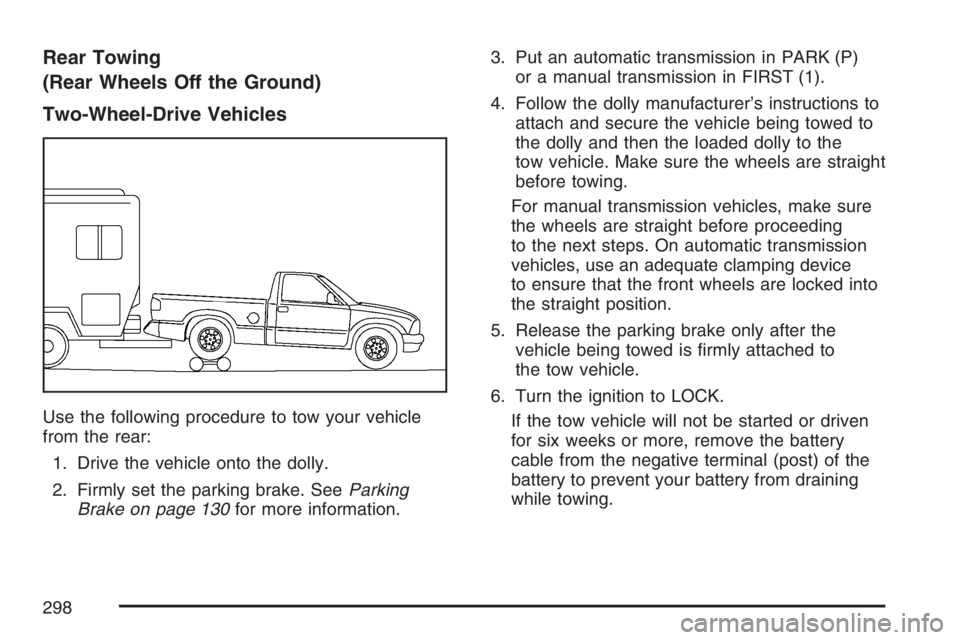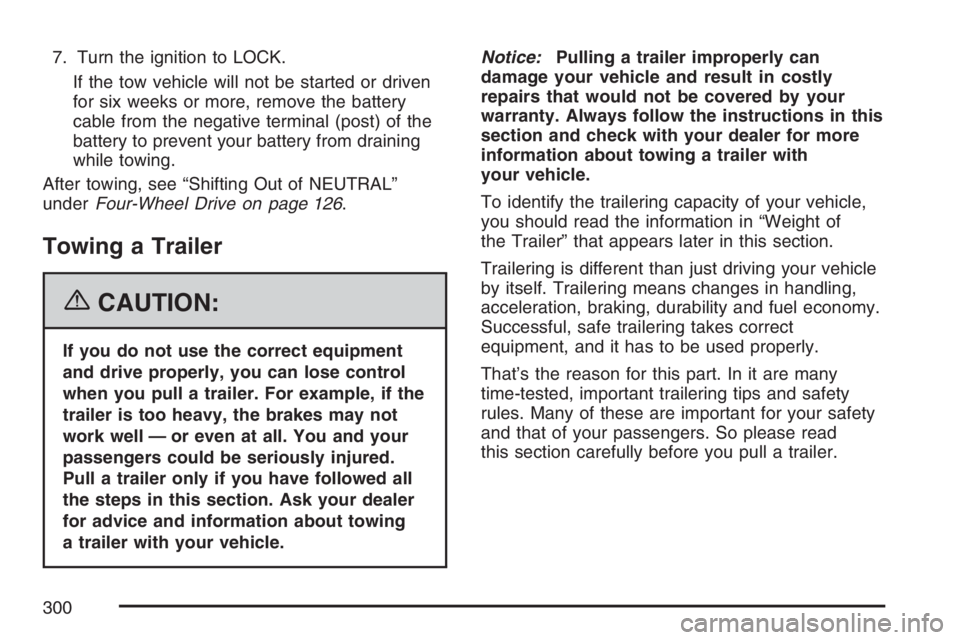2007 GMC CANYON wheel
[x] Cancel search: wheelPage 298 of 492

Rear Towing
(Rear Wheels Off the Ground)
Two-Wheel-Drive Vehicles
Use the following procedure to tow your vehicle
from the rear:
1. Drive the vehicle onto the dolly.
2. Firmly set the parking brake. SeeParking
Brake on page 130for more information.3. Put an automatic transmission in PARK (P)
or a manual transmission in FIRST (1).
4. Follow the dolly manufacturer’s instructions to
attach and secure the vehicle being towed to
the dolly and then the loaded dolly to the
tow vehicle. Make sure the wheels are straight
before towing.
For manual transmission vehicles, make sure
the wheels are straight before proceeding
to the next steps. On automatic transmission
vehicles, use an adequate clamping device
to ensure that the front wheels are locked into
the straight position.
5. Release the parking brake only after the
vehicle being towed is �rmly attached to
the tow vehicle.
6. Turn the ignition to LOCK.
If the tow vehicle will not be started or driven
for six weeks or more, remove the battery
cable from the negative terminal (post) of the
battery to prevent your battery from draining
while towing.
298
Page 299 of 492

Four-Wheel-Drive Vehicles
Use the following procedure to tow your vehicle
from the rear:
1. Drive the vehicle onto the dolly.
2. Firmly set the parking brake. SeeParking
Brake on page 130for more information.
3. Put an automatic transmission in PARK (P)
or a manual transmission in FIRST (1).
4. Follow the dolly manufacturer’s instructions
to attach and secure the vehicle being towed
to the dolly and then the loaded dolly to
the tow vehicle.For manual transmission vehicles, make sure
the wheels are straight before proceeding
to the next steps. On automatic transmission
vehicles, use an adequate clamping device
to ensure that the front wheels are locked into
the straight position.
{CAUTION:
Shifting a four-wheel-drive vehicle’s
transfer case into NEUTRAL can cause
your vehicle to roll even if the
transmission is in PARK (P) for an
automatic transmission, or if your vehicle
is in gear, for a manual transmission.
You or others could be injured. Make sure
the parking brake is �rmly set before you
shift the transfer case to NEUTRAL.
5. Shift the transfer case to NEUTRAL. See
Four-Wheel Drive on page 126for more
information.
6. Release the parking brake only after the
vehicle being towed is �rmly attached to the
tow vehicle.
299
Page 300 of 492

7. Turn the ignition to LOCK.
If the tow vehicle will not be started or driven
for six weeks or more, remove the battery
cable from the negative terminal (post) of the
battery to prevent your battery from draining
while towing.
After towing, see “Shifting Out of NEUTRAL”
underFour-Wheel Drive on page 126.
Towing a Trailer
{CAUTION:
If you do not use the correct equipment
and drive properly, you can lose control
when you pull a trailer. For example, if the
trailer is too heavy, the brakes may not
work well — or even at all. You and your
passengers could be seriously injured.
Pull a trailer only if you have followed all
the steps in this section. Ask your dealer
for advice and information about towing
a trailer with your vehicle.Notice:Pulling a trailer improperly can
damage your vehicle and result in costly
repairs that would not be covered by your
warranty. Always follow the instructions in this
section and check with your dealer for more
information about towing a trailer with
your vehicle.
To identify the trailering capacity of your vehicle,
you should read the information in “Weight of
the Trailer” that appears later in this section.
Trailering is different than just driving your vehicle
by itself. Trailering means changes in handling,
acceleration, braking, durability and fuel economy.
Successful, safe trailering takes correct
equipment, and it has to be used properly.
That’s the reason for this part. In it are many
time-tested, important trailering tips and safety
rules. Many of these are important for your safety
and that of your passengers. So please read
this section carefully before you pull a trailer.
300
Page 309 of 492

Backing Up
Hold the bottom of the steering wheel with
one hand. Then, to move the trailer to the left, just
move that hand to the left. To move the trailer to the
right, move your hand to the right. Always back up
slowly and, if possible, have someone guide you.
Making Turns
Notice:Making very sharp turns while
trailering could cause the trailer to come in
contact with the vehicle. Your vehicle could
be damaged. Avoid making very sharp
turns while trailering.
When you’re turning with a trailer, make wider
turns than normal. Do this so your trailer
won’t strike soft shoulders, curbs, road signs,
trees or other objects. Avoid jerky or sudden
maneuvers. Signal well in advance.
Turn Signals When Towing a Trailer
When you tow a trailer, your vehicle has to have
extra wiring and a heavy-duty turn signal �asher.
The arrows on your instrument panel will �ash
whenever you signal a turn or lane change.
Properly hooked up, the trailer lamps will also
�ash, telling other drivers you’re about to
turn, change lanes or stop.When towing a trailer, the arrows on your
instrument panel will �ash for turns even if the bulbs
on the trailer are burned out. Thus, you may think
drivers behind you are seeing your signal when
they are not. It’s important to check occasionally to
be sure the trailer bulbs are still working.
Driving On Grades
Reduce speed and shift to a lower gear before
you start down a long or steep downgrade. If you
don’t shift down, you might have to use your
brakes so much that they would get hot and no
longer work well.
When towing at high altitude on steep uphill
grades, consider the following: Engine coolant
will boil at a lower temperature than at normal
altitudes. If you turn your engine off immediately
after towing at high altitude on steep uphill grades,
your vehicle may show signs similar to engine
overheating. To avoid this, let the engine run while
parked (preferably on level ground) with the
automatic transmission in PARK (P) (or the manual
transmission out of gear and the parking brake
applied) for a few minutes before turning the
engine off. If you do get the overheat warning,
seeEngine Overheating on page 340.
309
Page 310 of 492

Parking on Hills
{CAUTION:
You really should not park your
vehicle, with a trailer attached, on a hill.
If something goes wrong, your rig could
start to move. People can be injured,
and both your vehicle and the trailer can
be damaged.
But if you ever have to park your rig on a hill,
here’s how to do it:
1. Apply your regular brakes, but don’t shift into
PARK (P) yet, or into gear for a manual
transmission. When parking uphill, turn your
wheels away from the curb. When parking
downhill, turn your wheels into the curb.
2. Have someone place chocks under the trailer
wheels.
3. When the wheel chocks are in place, release
the regular brakes until the chocks absorb
the load.4. Reapply the regular brakes. Then apply your
parking brake, and then shift into PARK (P),
or REVERSE (R) for a manual transmission.
SeeParking Brake on page 130for more
information.
5. If you have a four-wheel-drive vehicle, be sure
the transfer case is in a drive gear and not in
NEUTRAL. SeeFour-Wheel Drive on page 126
for more information.
6. Release the regular brakes.
When You Are Ready to Leave After
Parking on a Hill
1. Apply your regular brakes and hold the pedal
down while you:
start your engine,
shift into a gear, and
release the parking brake.
2. Let up on the brake pedal.
3. Drive slowly until the trailer is clear of the
chocks.
4. Stop and have someone pick up and store
the chocks.
310
Page 313 of 492

Service........................................................ 316
Accessories and Modi�cations................... 316
California Proposition 65 Warning.............. 317
Doing Your Own Service Work.................. 317
Adding Equipment to the Outside of
Your Vehicle.......................................... 318
Fuel............................................................. 318
Gasoline Octane........................................ 318
Gasoline Speci�cations.............................. 318
California Fuel........................................... 318
Additives................................................... 319
Fuels in Foreign Countries........................ 320
Filling the Tank......................................... 320
Filling a Portable Fuel Container............... 322
Checking Things Under the Hood.............. 323
Hood Release........................................... 323
Engine Compartment Overview.................. 324
Engine Oil................................................. 325Engine Oil Life System.............................. 328
Engine Air Cleaner/Filter............................ 330
Automatic Transmission Fluid.................... 331
Manual Transmission Fluid........................ 334
Hydraulic Clutch........................................ 336
Engine Coolant.......................................... 337
Radiator Pressure Cap.............................. 340
Engine Overheating................................... 340
Cooling System......................................... 342
Engine Fan Noise..................................... 347
Power Steering Fluid ................................. 348
Windshield Washer Fluid........................... 349
Brakes...................................................... 350
Battery...................................................... 353
Jump Starting............................................ 354
Rear Axle.................................................... 359
Four-Wheel Drive........................................ 359
Front Axle................................................... 360
Section 5 Service and Appearance Care
313
Page 314 of 492

Bulb Replacement....................................... 361
Halogen Bulbs........................................... 361
Headlamps................................................ 362
Front Turn Signal, Parking and
Daytime Running Lamps (DRL).............. 363
Center High-Mounted Stoplamp (CHMSL) ... 364
Taillamps, Turn Signal, Stoplamps and
Back-up Lamps...................................... 364
License Plate Lamp................................... 366
Replacement Bulbs................................... 366
Windshield Wiper Blade Replacement....... 367
Tires............................................................ 369
Tire Sidewall Labeling............................... 370
Tire Terminology and De�nitions............... 374
In�ation - Tire Pressure............................. 377
Tire Pressure Monitor System................... 378
Tire Inspection and Rotation...................... 383
When It Is Time for New Tires.................. 385
Buying New Tires...................................... 386
Different Size Tires and Wheels................ 388
Uniform Tire Quality Grading..................... 389
Wheel Alignment and Tire Balance............ 390
Wheel Replacement.................................. 390Tire Chains............................................... 392
If a Tire Goes Flat.................................... 393
Changing a Flat Tire................................. 394
Removing the Spare Tire and Tools.......... 395
Removing the Flat Tire and
Installing the Spare Tire......................... 398
Secondary Latch System........................... 406
Storing a Flat or Spare Tire and Tools...... 410
Spare Tire................................................. 413
Appearance Care........................................ 415
Cleaning the Inside of Your Vehicle.......... 415
Fabric/Carpet............................................. 416
Leather...................................................... 417
Instrument Panel, Vinyl, and
Other Plastic Surfaces........................... 418
Care of Safety Belts.................................. 418
Weatherstrips............................................ 418
Washing Your Vehicle............................... 419
Cleaning Exterior Lamps/Lenses................ 419
Finish Care............................................... 419
Windshield and Wiper Blades.................... 420
Aluminum or Chrome-Plated Wheels......... 421
Tires......................................................... 422
Section 5 Service and Appearance Care
314
Page 352 of 492

Brake Wear
Your vehicle has front disc brakes and rear
drum brakes.
Disc brake pads have built-in wear indicators that
make a high-pitched warning sound when the
brake pads are worn and new pads are needed.
The sound may come and go or be heard all
the time your vehicle is moving, except when you
are pushing on the brake pedal �rmly.
{CAUTION:
The brake wear warning sound means that
soon the brakes will not work well. That
could lead to an accident. When you hear
the brake wear warning sound, have your
vehicle serviced.
Notice:Continuing to drive with worn-out
brake pads could result in costly brake repair.
Some driving conditions or climates may cause
a brake squeal when the brakes are �rst applied or
lightly applied. This does not mean something is
wrong with the brakes.Properly torqued wheel nuts are necessary to help
prevent brake pulsation. When tires are rotated,
inspect brake pads for wear and evenly tighten
wheel nuts in the proper sequence to GM torque
speci�cations.
Rear drum brakes do not have wear indicators,
but if you ever hear a rear brake rubbing
noise, have the rear brake linings inspected
immediately. Also, the rear brake drums should be
removed and inspected each time the tires are
removed for rotation or changing. When you have
the front brake pads replaced, have the rear
brakes inspected, too.
Brake linings should always be replaced as
complete axle sets.
Brake Pedal Travel
See your dealer if the brake pedal does not return
to normal height, or if there is a rapid increase in
pedal travel. This could be a sign of brake trouble.
Brake Adjustment
Every time you make a brake stop, the brakes
adjust for wear.
352